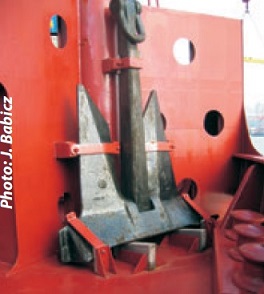
Anchor Handling Equipment for Cargo Ships
Anchors are heavy forging or casting shaped to grip the sea bottom, and by means of a cable
or rope, holds a ship or other floating structure in a desired position regardless of wind
and current. Different types are in use: stock-anchors, stockless anchors (SPEK or HALL
type), High Holding Power (HHP) anchors, Super Holding Power (SHHP) anchors.
Anchoring equipment is designed for temporary mooring a vessel within a harbour or sheltered area when the vessel is awaiting berth, etc. It is assumed that under normal circumstances a ship will use only one bow anchor and chain cable at a time.
Anchoring equipment is designed for temporary mooring a vessel within a harbour or sheltered area when the vessel is awaiting berth, etc. It is assumed that under normal circumstances a ship will use only one bow anchor and chain cable at a time.



